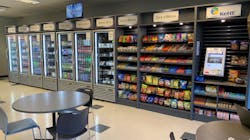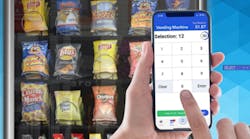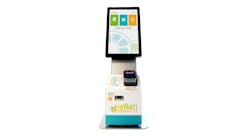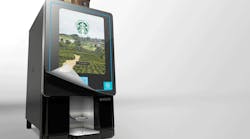The COVID-19 pandemic had a profound effect on vending and micro market operations nationwide. Because of their ease of use and ability to deliver packaged fresh foods in a safe setting, micro markets enjoyed widespread adoption in open workplaces, replacing manual cafeterias in some instances.
At the onset of the pandemic, and throughout, while many suppliers experienced an expected dip in sales, they also found that demand for new automated food delivery solutions created opportunities that offset workplace shutdowns and drastically reduced onsite populations in locations that didn’t close.
Many micro market designers and suppliers of shelving, fixtures and coolers made changes and enhancements to their product lines inspired by new demands during the pandemic, which are likely to endure as the world continues to reopen.
PANDEMIC IMPACT
“In the white-collar world, demand dipped as more workers moved to a work-from-home strategy,” said micro market design pro Steve Orlando, cofounder of Phoenix-based Fixturelite.
“In the blue-collar world, demand skyrocketed as markets in a grab-no-go format replaced the cafeteria line...a trend we see continuing,” he added. “Additionally, the need for micro markets in places they never would have been before and selling products not traditionally offered in a market environment jumped to help service the make-shift hospitals, laboratory, manufacturing and first responder industries.”
Christopher Blomquist of San Antonio, TX-based micro market, vending and dining technology provider Parlevel Systems echoed Orlando’s experience, noting that throughout the pandemic, locations were affected differently not only by venue type, but also geography.
“White-collar and office locations found decreased market sales as workers were sent home, while blue-collar and manufacturing facilities stayed constant,” he commented. “Depending on where COVID-19 hotspots were located, different states experienced slowdowns at different times. As traffic slowed down in some locations, operators also asked for a smart-cooler-type solution.”
Smart coolers, available from several suppliers and growing in popularity as a vending machine/micro market hybrid of sorts, feature locked doors that can only be accessed when the patron presents a payment method. When opened, a smart cooler detects exactly what product the customer selects and charges them accordingly.
He added that Parlevel’s focus since the start of the pandemic was to provide operators with hygienic solutions for their locations. So, Parlevel focused heavily on providing materials and best practices to keep their markets clean and safe.
Bear Wegener of Aurora, IL-based micro market design and fixture provider Axis Designs said that after the initial effect of the shutdown, his company saw a rise in demand for self-service, grab-and-go market solutions.
“People are looking for prepackaged food solutions opposed to full-service cafeterias and self-serve salad bars,” he noted. “As workplaces reopen, this movement will continue to fuel micro market demand.”
Sam Arrington of Genesis Décor, a supplier of micro market cabinetry, décor and signage, said the Amelia, VA-based company’s sales were negatively impacted by the pandemic in 2020, resulting in its first sales loss since the 2008 recession. But business is now moving in the right direction.
“Thankfully, that trend has reversed, and we foresee a very busy second half of 2021,” he remarked.
SIGNS OF THE TIMES
The beauty of micro markets is their modular nature that not only allows operators to customize them to meet location needs, but also to adapt them as those needs change, which was the case nearly across the board during the pandemic.
Axis Designs stepped up to the plate with a few innovative concepts to answer new demands. They included a self-serve, prepackaged vertical salad bar; a self-serve grocery retail store open to the general public; and mobile micro market fixtures. For other locations, it added rolldown security gates on market fixtures and island-style preorder and point-of-sale stations with product merchandising.
Fixturelite’s Orlando emphasized that solutions that are modular, low- or no-touch, and that provide distancing are important. Fixturelite introduced its Pop-Up collection, which makes it simple for patrons to order and understand, fast to set up in the field and easily mobile when it needs to relocate.
“It’s flexible in how it lays out and can grow in size to meet population demand, and it’s super affordable to the operator,” Orlando noted.
Additionally, Fixturelite has seen a surge in its Off the Wall collection, which moves such market features as snack, coffee and checkout away from the wall to allow more distancing and better traffic flow in the market.
“We didn’t make many changes to our product lines, but we did take maximum advantage of the slowdown in sales to improve our processes and efficiencies in-house,” said Genesis Décor’s Arrington. “This will pay huge dividends in our production efficiency and turnaround time as sales continue to grow. In general, we see a continuing trend of installing markets in smaller accounts. Another sign of the times is increased material costs. We have been working hard to absorb cost increases as we can, but as prices continue to rise, we may have no choice but to raise prices on many of our products.”
In the heat of the pandemic, Parlevel’s customers sought guidelines on how to advertise their micro market services as safe and hygienic, which led to the retail technology company’s establishing and promoting best operational practices.
“We recommended best practices for screen cleaning, PPE stocking and hand sanitizer stations,” Blomquist said. “We also created our hubz Smart Cooler – a locking fridge stocked with diverse items – that marries the security of a vending machine with the product diversity of a micro market to help operators appeal to a wider array of locations.”
RAMPING BACK UP
As the pandemic continues to wind down, several micro market fixture suppliers say they are seeing a return to pre-pandemic-period design demands.
“We anticipate an uptick in demand for micro market fixtures and full breakroom designs as employees return to their workplaces,” Wegener said.
Orlando predicts that pre-pandemic designs are going to continue to change to meet the new demands employees are going to have when they return to work. “They want to feel safe and supported by their employer, so designs will have to change to meet these new requirements,” he said.
Parlevel’s Blomquist sees micro market demand slowly returning to pre-pandemic levels, but it’s still 30% to 40% less than at its peak. “However, account viability has shifted,” he said. “Some previously profitable accounts have reduced their workforces, while other less-desirable accounts have increased numbers. This leads operators to reexamine which locations make sense for their business.”
Arrington said that as of mid-May, Genesis Décor was seeing a dramatic upswing in requests for designs, quotes and orders to pre-pandemic levels.
NONTRADITIONAL LOCATIONS
Many micro market suppliers have seen new demands in nontraditional, non-workplace venues, including semi-public locations like healthcare facilities and apartment complexes.
Axis’s Wegener said he is seeing self-pay kiosks being deployed in semi-public spaces like retail storefronts and college campus student dorm complexes.
Orlando observed that workers always need access to some type of refreshment solution. “Throughout the pandemic, unique solutions, like Fixturelite’s pop-up market, were implemented to respond to new needs. As workplaces begin to reopen in a whole new way, solutions previously implemented will change to meet the new demands of smaller populations, more distancing and less-touch.”
Blomquist said that while Parlevel did witness an uptick in nontraditional locations throughout the pandemic, what it really experienced was an expansion of services within established locations coupled with more sites being receptive to trying unattended services that they previously were not open to trying.
OPERATOR-DRIVEN DESIGNS
All the micro market suppliers interviewed for this article agree that their operator customers ultimately drive the designs that best suit their locations, and it’s then the supplier’s job to deliver it to them.
“There is no ‘best’ design or one-box solution; only a best design for that customer,” Orlando emphasized. “Markets must be customized to each customer’s unique requirements. In some cases, it may be a Fixturelite pop-up market, in others it may be all custom, and in others it may be a customized solution using stock Fixturelite pieces.”
Fixturelite has a proprietary process for helping a customer assess their needs and collaboratively creating a solution that meets or exceeds them.
Parlevel’s Blomquist agreed that experienced operators know that the best design is the one that works for the customers they are going to serve. “So, they need to take into account the number of people who will buy from the micro market, the type of product they are likely to consume, the location space, the break-times, extra services to incentivize more sales, etc.,” he instanced.
While he agrees that there is not one “best design,” Wegener added that Axis’s Premium In-Line Micro-Market Fixture package is its most popular solution used in creating “showcase accounts” for operators. Its freestanding mobile merchandisers are also popular for the ease of installing a completely assembled fixture.
“We continue to listen to operators to determine how we create the best solution to their challenges,” Wegener said. “Often we will customize based upon these needs.”
Genesis’s Arrington said one of his company’s greatest strengths is being able to provide customized solutions to its customers in a short timeline. “For fairly straightforward designs, we can usually turn around renderings and drawings the same or next day,” he said. “We create and print our own graphics inhouse, so we can easily and quickly incorporate custom designs and logos that give our customers an edge.”
He added that Genesis Décor’s standard designs are almost all “parametric,” meaning that the micro market designer and provider can easily enter custom height, width and depth dimensions of cabinetry to precisely fit the customer’s available space.
“And our design system automatically calculates the sizes of all the various parts needed and sends the designs to our computer numerical control equipment, which accurately cuts out the parts,” the design expert explained. “Once our customer provides us with any space constraints, this system gives us tremendous flexibility to create optimum solutions.”
Blomquist said Parlevel works closely with operators to see what micro market or unattended retail solution works best for their locations. “Often, we will walk through a checklist with operators to review questions like the number of onsite employees, location type, number of shifts, nearby food options, and other items to examine the best setup for them,” he said. “We’ll then create a mockup custom to the location that the customer can use to pitch and close the account.”
SUPPLY CHAIN DISRUPTIONS
In some cases, supply chain disruptions brought on by the pandemic appear to be easing but in others they’re affecting delivery time for products and other supplies for micro markets.
“Supply chain disruptions are going to worsen before they start to get better,” Fixturelite cofounder Troy Geis predicted. “It’s the perfect storm of the pandemic: a significant lull in demand, severe weather and fires, a large shortage of labor, and finally an unprecedented surge in demand. Everything in the supply chain is interconnected very deeply and one small blip in the chain has a ripple effect that can spread widely.”
Take for example the recent significant surge in rental car rates, he pointed out, which rippled because when the pandemic started, rental car companies purged their fleets to conserve cash. When demand skyrocketed for rental cars as Americans started traveling again, the rental companies were unable to replace the cars they had purged as there is a worldwide chip shortage and car manufacturers are unable to manufacture cars. So, the demand outweighs the supply of rental cars available because of a shortage of chips.
Blomquist agreed with Geis that certain sectors of the supply chain are especially seeing the most disruption while others have been spared.
“For most food and beverage items, it seems to be okay,” he said. “For electronics, currently, it is in disarray. We estimate the overstocking of components by big-market players like auto and appliance makers are causing much of the issues and will not ease the flow of components until next year.”
Axis’ Wegener added, “supply chain disruptions as well as raw material costs are worsening and, in my opinion, the effects of the shutdown on the economy is not yet fully realized.”
Arrington counts Genesis Décor lucky. Although there are issues with the supply chains, they have not affected the company’s delivery times at all. “We were very proactive many months ago, anticipating disruptions, and dramatically increased the amount of inventory and raw materials that we stocked inhouse while supplies were plentiful and prices were ‘normal,’” he said. “This ensured that our customers continued to receive their orders on time. It was a wise investment.”
WHAT’S NEXT?
Wegener believes that operators’ accounts will start demanding full-room designs accommodating ancillary items such as seating, employee prep stations, lunch storage space and waste receptacles to illustrate the overall breakroom experience.
A prevailing trend Orlando sees is leaning toward designs accommodating “grab-and-go”-style sales replacing foodservice lines in sites ranging from factories to hospitality. “The food is still made fresh...just minutes ago in many cases,” he pointed out. “And its available for a consumer to grab and self-checkout in a more touchless, more distanced environment.”
Arrington said Genesis Décor’s customers seem to prefer its modular, prebuilt units, requiring no assembly and minimal time onsite. “While this increases the cost of shipping, the speed and ease of installation seems more important in most cases, especially as accounts are concerned about exposure to operators’ installation teams from outside the account’s ‘COVID bubble,’” Arrington observed.
Genesis currently has two modular product lines, the Market Basics and the Elite. It’s also introducing a line at The NAMA Show in New Orleans in August called Latitude that Arrington says “fills the sweet spot in the middle of our product and price range.” Also coming is a modular line of cabinets for office coffee service settings.
Parlevel’s Blomquist said an effective locking cooler is at the top of the collective industry’s minds. “Operators are looking for a solution that enables them to sell higher-priced items in locations with high in-and-out traffic,” he commented.
Amid the disruption the pandemic caused, the next round of automatic retailing ingenuity has moved to the forefront as the pace of re-openings begins to pickup. ■
365's Dream Market
If you’re a leading micro market technology company, it’s logical that the breakroom at your own office showcases the best unattended retail equipment and fixtures the industry has to offer, and in an attractive space. With that in mind, 365 Retail Markets redesigned its own micro market lounge at its new Troy, MI, headquarters. The remodeled micro market doubles as a showroom for visitors, as well as a training lab for operators and 365 employees.
365 created a neutral space with seven areas that will allow visitors to envision what could be built in their own spaces. The multifunctional market lends itself to company meetings, film and video shoots, and marketing and training sessions. It will display checkout kiosks, the Pico Cooler and mobile ordering apps, among other 365 micro market technologies. The micro market company teamed up with Fixturelite, a breakroom engineering and design specialist, to design the new showroom.
“Because we have such a robust support team, we have internal training every day,” said Linde Hutson, 365’s director of global marketing, communications and training. “We have continuing education because we want everybody at 365 to know what we do, how we do it and how every system works. We also conduct 12 to 18 external operator training sessions of our systems per week. This market showroom is a really good place for people to receive more hands-on training.”

Emily Jed
Emily Jed is a business journalist who has devoted much of her career to covering the convenience services industry. She is a contributing editor to Automatic Merchandiser/VendingMarketWatch.com.








